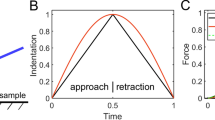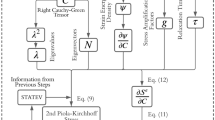Abstract
Instrumented indentation is often used in the study of small-scale mechanical behavior of “soft” matters that exhibit viscoelastic behavior. A number of techniques have recently been proposed to obtain the viscoelastic properties from indentation load–displacement curves. In this study, we examine the relationships between initial unloading slope, contact depth, and the instantaneous elastic modulus for instrumented indentation in linear viscoelastic solids using either conical or spherical indenters. In particular, we study the effects of “hold-at-the-peak-load” and “hold-at-the-maximum-displacement” on initial unloading slopes and contact depths. We then discuss the applicability of the Oliver–Pharr method (Refs. 29, 30) for determining contact depth that was originally proposed for indentation in elastic and elastic-plastic solids and recently modified by Ngan et al. (Refs. 20–23) for viscoelastic solids. The results of this study should help facilitate the analysis of instrumented indentation measurements in linear viscoelastic solids.
Similar content being viewed by others
References
E.H. Lee: Stress analysis in visco-elastic bodies. Quarterly Appl. Math. 13, 183 (1955).
J.R.M. Radok: Visco-elastic stress analysis. Quarterly Appl. Math. 15, 198 (1957).
E.H. Lee and J.R.M. Radok: The contact problem for viscoelastic bodies. J. Appl. Mech. 27, 438 (1960).
S.C. Hunter: The Hertz problem for a rigid spherical indenter and a viscoelastic half-space. J. Mech. Phys. Solids 8, 219 (1960).
G.A.C. Graham: The contact problem in the linear theory of viscoelasticity. Int. J. Eng. Sci. 3, 27 (1965).
G.A.C. Graham: Contact problem in linear theory of viscoelsticity when time dependent contact area has any number of maxima and minima. Int. J. Eng. Sci. 5, 495 (1967).
W.H. Yang: Contact problem for viscoelastic bodies. J. Appl. Mech. 33, 395 (1966).
T.C.T. Ting: Contact stresses between a rigid indenter and a viscoelastic half-space. J. Appl. Mech. 33, 845 (1966).
T.C.T. Ting: Contact problems in linear theory of viscoelasticity. J. Appl. Mech. 35, 248 (1968).
B.J. Briscoe, L. Fiori and E. Pelillo: Nano-indentation of polymeric surfaces. J. Phys. D, Appl. Phys. 31, 2395 (1998).
P.L. Larrson and S. Carlsson: On microindentation of viscoelastic polymers. Polym. Testing 17, 49 (1998).
L. Cheng, X. Xia, W. Yu, L.E. Scriven and W.W. Gerberich: Flat-punch indentation of viscoelastic material. J. Polym. Sci. B, Polym. Phys 38, 10 (2001).
S. Shimizu, T. Yanagimoto and M. Sakai: Pyramidal indentation load-depth curve of viscoelastic materials. J. Mater. Res. 14, 4075 (1999).
M. Sakai and S. Shimizu: Indentation rheometry for glass-forming materials. J. Non-Cryst. Solids 282, 236 (2001).
M. Sakai: Time-dependent viscoelastic relation between load and penetration for an axisymmetric indenter. Philos. Mag. A82, 1841 (2002).
M.L. Oyen and R.F. Cook: Load-displacement behavior during sharp indentation of viscous-elastic-plastic materials. J. Mater. Res. 18, 139 (2003).
M.R. VanLandingham: Review of instrumented indentation. J. Res. Nat. Inst. Stand. Technol. 108, 249 (2003).
H. Lu, B. Wang, J. Ma, G. Huang and H. Viswanathan: Measurement of creep compliance of solid polymers by nanoindentation. Mech. Time-Dependent Mater. 7, 189 (2003).
M.V.R. Kumar and R. Narasimhan: Analysis of spherical indentation of linear viscoelastic materials. Curr. Sci. 87, 1088 (2004).
G. Feng and A.H.W. Ngan: Effects of creep and thermal drift on modulus measurement using depth-sensing indentation. J. Mater. Res. 17, 660 (2002).
A.H.W. Ngan and B. Tang: Viscoelastic effects during unloading in depth-sensing indentation. J. Mater. Res. 17, 2604 (2002).
B. Tang and A.H.W. Ngan: Accurate measurement of tip-sample contact size during nanoindentation of viscoelastic materials. J. Mater. Res. 18, 1141 (2003).
A.H.W. Ngan, H.T. Wang, B. Tang and K.Y. Sze: Correcting power-law viscoelastic effects in elastic modulus measurement using depth-sensing indentation. Int. J. Solids Struct. 42, 1831 (2005).
Y.T. Cheng and C.M. Cheng: Scaling, dimensional analysis, and indentation measurements. Mater. Sci. Eng. R44, 91 (2004).
Y.T. Cheng and C.M. Cheng: Relationships between initial unloading slope, contact depth, and mechanical properties for conical indentation in linear viscoelastic solids. J. Mater. Res. 20, 1046 (2005).
Y.T. Cheng and C.M. Cheng: Relationships between initial unloading slope, contact depth, and mechanical properties for spherical indentation in linear viscoelastic solids. Mater. Sci. Eng., A (in press).
Y.T. Cheng and C.M. Cheng: A general relationship between contact stiffness, contact depth, and mechanical properties for indentation in linear viscoelastic solids using axisymmetric indenters of arbitrary profiles. Appl. Phys. Lett. 87, 111914 (2005).
M.F. Doerner and W.D. Nix: A method for interpreting the data from depth-sensing indentation instruments. J. Mater. Res. 1, 601 (1986).
G.M. Pharr, W.C. Oliver and F.R. Brotzen: On the generality of the relationship between contact stiffness, contact area, and elastic modulus during indentation. J. Mater. Res. 7, 613 (1992).
W.C. Oliver and G.M. Pharr: An improved technique for determining hardness and elastic modulus using load and displacement sensing indentation experiments. J. Mater. Res. 7, 1564 (1992).
S.P. Timoshenko and J.N. Goodier: Theory of Elasticity, 3rd ed. (McGraw-Hill, New York, 1970).
A.E.H. Love: Boussinesq’s problem for a rigid cone. Quart. J. Math. 10, 161 (1939).
I.N. Sneddon: The relation between load and penetration in the axisymmetric Boussinesq problem for a punch of arbitrary profile. Int. J. Eng. Sci. 3, 47 (1965).
C.M. Cheng and Y.T. Cheng: On the initial unloading slope in indentation of elastic-plastic solids by an indenter with an axisymmetric smooth profile. Appl. Phys. Lett. 71, 2623 (1997).
W.N. Findley, J.S. Lai and K. Onaran: Creep and Relaxation of Nonlinear Viscoelastic Materials (Dover, New York, 1976).
G.T. Mase and G.E. Mase: Continuum Mechanics for Engineers, 2nd ed. (CRC, Boca Raton, FL, 1999).
W. Ni, Y.T. Cheng, C.M. Cheng and D.S. Grummon: An energy based method for analyzing instrumented spherical indentation experiments. J. Mater. Res. 19, 149 (2004).
Author information
Authors and Affiliations
Corresponding author
Additional information
This author was an editor of this journal during the review and decision stage. For the JMR policy on review and publication of manuscripts authored by editors, please refer to http://www.mrs.org/publications/jmr/policy.html.
Rights and permissions
About this article
Cite this article
Cheng, YT., Ni, W. & Cheng, CM. Determining the instantaneous modulus of viscoelastic solids using instrumented indentation measurements. Journal of Materials Research 20, 3061–3071 (2005). https://doi.org/10.1557/JMR.2005.0389
Received:
Accepted:
Published:
Issue Date:
DOI: https://doi.org/10.1557/JMR.2005.0389




